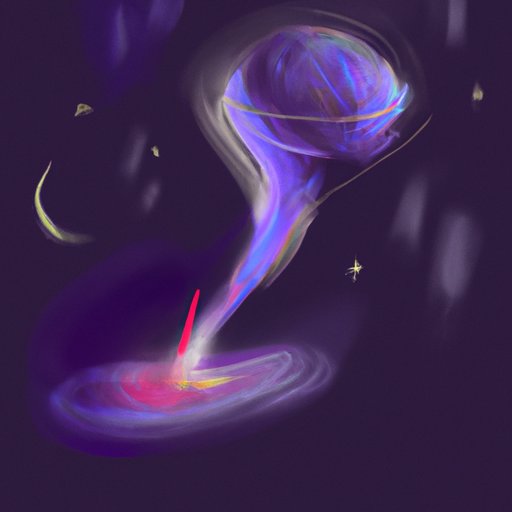Introduction
Drawing space in art is one of the most captivating and challenging endeavors that an artist can take on. By experimenting with color and shapes, applying perspective techniques, and incorporating elements of fantasy, you can create artwork that captures the beauty and mystery of outer space.
For the purpose of this article, “space” refers to the universe beyond Earth, including galaxies, planets, stars, and other celestial bodies. In art, space can be represented in many different ways, from realistic depictions to abstract forms.
This article will provide a step-by-step guide to drawing space in art, exploring the use of color and shapes to create a sense of depth and dimension in artwork, and offering tips and techniques for capturing the mystery of outer space.
Step-by-Step Guide to Drawing Space in Art
When creating artwork depicting space, it’s important to start with basic shapes. Begin by sketching out the scene, using circles, ovals, squares, and rectangles to form the various elements. This will help you to establish the overall composition of your piece and develop a sense of balance and structure.
Once you have sketched out the basic shapes, you can begin to add details and shadows. This will help to create a sense of depth and dimension in the artwork. Pay attention to how light sources affect the shadows and highlights on each element, as this will help to bring your artwork to life.
When drawing space, it’s important to capture the movement and energy of the scene. Experiment with adding wavy lines and sweeping curves to suggest motion and energy. You can also use light and shadow to create a sense of depth and texture.

Exploring the Use of Color and Shapes to Create Space in Art
Color plays an important role in creating a sense of depth and dimension in artwork. Choose colors that evoke a sense of depth, such as blues and purples for a night sky, or oranges and yellows for a sunrise. You can also use contrasting colors to make certain elements stand out.
Lines are also useful when creating artwork depicting space. Use curved and straight lines to create a dimensional effect, and experiment with combining shapes to suggest space. For example, overlapping circles can be used to suggest planets, while two sets of parallel lines can be used to depict a horizon line.
Tips and Techniques for Creating Depth and Dimension in Artwork
When creating artwork depicting space, it’s important to utilize light and shadow to create a sense of depth and dimension. Pay attention to where the light sources are coming from, and think about how they will affect the shadows and highlights on each element.
Perspective is another useful technique when creating artwork depicting space. Understanding the basics of linear perspective, such as one, two, and three point perspective, will help you to create a sense of depth and distance. You can also incorporate atmospheric perspective, which uses color and value to suggest distance.
Finally, don’t forget to incorporate texture into your artwork. Textures can be used to suggest different surfaces, such as rocky planets or nebula clouds, and can help to create a sense of depth and dimension.

Using Perspective to Create a Sense of Space in Art
Perspective is one of the most important tools for creating a sense of space in artwork. Understanding the basics of linear perspective will help you to create a sense of depth and distance.
One point perspective is used to create a flat, two-dimensional look. Two point perspective is used to create a more three-dimensional effect, and is often used for scenes with buildings or other structures. Three point perspective is used to create a sense of depth, and is often used for landscapes.
Atmospheric perspective is also useful for creating a sense of depth and distance in artwork. This technique uses color and value to suggest distance, with darker values being used for objects in the foreground and lighter values being used for objects in the background.

Capturing the Mystery of Outer Space in Art
When creating artwork depicting outer space, it’s important to focus on the stars. Experiment with different techniques, such as stippling and cross-hatching, to capture the twinkling of the stars. You can also use points of light to suggest planets or other celestial bodies.
It’s also important to express the vastness of outer space in your artwork. You can do this by using sweeping lines and curves to suggest movement and energy, or by incorporating elements of fantasy, such as mythical creatures or imaginary landscapes.
Creative Ideas for Representing the Galaxy in Art
There are many creative ways to represent the galaxy in art. One approach is to use iconic symbols to suggest celestial bodies, such as stars, planets, and comets. You can also create imaginary landscapes, such as a cityscape on a distant planet, or experiment with abstract forms to suggest the mysterious depths of space.
Another approach is to focus on the colors of the night sky. Experiment with combinations of blues and purples to evoke a sense of mystery and awe. You can also use light and shadows to create a sense of depth and dimension in your artwork.
Conclusion
Drawing space in art is a captivating and challenging endeavor that requires experimentation and exploration. It can be achieved by sketching basic shapes, adding details and shadows, and utilizing perspective techniques. Additionally, it’s important to consider the use of color and shapes to create a sense of depth and dimension in artwork, as well as the use of light and shadow to capture the mystery of outer space.
By following these steps and exploring creative ideas for representing the galaxy, you can create artwork that captures the beauty and mystery of outer space.
(Note: Is this article not meeting your expectations? Do you have knowledge or insights to share? Unlock new opportunities and expand your reach by joining our authors team. Click Registration to join us and share your expertise with our readers.)
